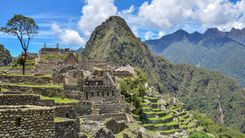Trekking in and around the Colca Canyon
There are dozens of trekking routes in the Colca Canyon, but if you’re planning on descending to the canyon floor, even if just for the day, it’s best to be fit and prepared for the altitude – it’s tough going and becomes quite dangerous in sections. Make sure to check whether oxygen is provided by your tour operator – even a bus trip to Chivay can bring on mountain sickness if you’ve only recently arrived from sea level. If you start trekking from Cabanaconde, or visit this town beforehand, it is worth visiting the tourist information centre and also checking out the cost of guides, arrieros (muleteers) and mules.
Treks from Cabanaconde
Mirador Achachina Walk A fifteen-minute stroll from the plaza in Cabanaconde takes you past the bullring to the Mirador Achachina, a good spot for spotting condors and viewing the western end of the valley from above.
Basic Colca Trek The start of the classic route from Cabanaconde to the bottom of the Colca Canyon can be reached just ten minutes’ walk along a fairly clear track beyond the newly constructed Casa de Pablo hostel, itself a five-minute walk from the plaza. The descent from here follows an incredibly steep path, quite dangerous in parts, down to the Oasis, a rustic lodge and campsite right in the bottom of the canyon; it takes one and a half to two hours to descend and four or five to get back up. Many people stay the night.
The Tapay Trail This well-used trekking route connects Cabanaconde with the small settlement of Tapay via the Oasis. It is a two- to four-day return hike through fine scenery, immense canyons, tiny hamlets like Cosñirhua (2350m) and Malata as well as various Inca and pre-Inca ruins. Save for the aforementioned campsite – which you’ll pass on the first morning – there are no facilities at all in the area.
Cabanaconde to Lake Mucurca There is a popular eight-hour hike from Cabanaconde that culminates at Lake Mucurca (4000m). At its end point the astonishingly beautiful Ampato volcano is reflected in the lake’s crystalline waters.
The Ampato Trail From Lake Mucurca the adventurous, fully acclimatized and well prepared can trek all the way around snowcapped Ampato (four to six days). The Ampato Trail has one very high pass – around 4850m at the crossing of two trails on Cerro Quenahuane, above the Quebrada Condori – and most of the walking is at over 4200m. Local guides are a good idea and you will need food and camping equipment. Be prepared for snow and ice; the weather can change very fast. On the last downhill leg of the trek you can choose to follow trails back to Achoma, Maca or Cabanaconde.
The Colcas de Chichinia trek
A relatively easy two-hour walk from the village of Corporaque (15min by car or bus from Chivay, on the opposite side of the Colca Canyon to Maca and the Mirador Cruz del Condor), takes in the Colcas de Chichinia, a semi-intact set of pre-Inca Huari tombs; today they lie today exposed at the foot of the cliffs on Cerro Yurac Ccacca (also known as Cerro San Antonio). A path leads out a couple of blocks just below the plaza in Corporaque, crossing the stream as you leave the settlement behind and climbing steadily towards a prominent, pink rocky outcrop. Because it’s little visited, the entry path to the site isn’t marked and more or less leaves you to find your own route; given this, it’s important to take care not to damage the stone walls and agricultural plots you have to find your way through.
The tombs are just below the 4000m contour line where several overhangs have been partially filled in with stone as permanent thrones for pre-Inca mummies, placed here ceremoniously to spend eternity watching over the valley and gazing east towards several sacred mountain peaks. These days, after the ravages of time and grave-robbers, all that is left of the mummies are skulls and skeletons, some with hair and a few with remnants of the rope and cloth they were originally wrapped in.
To the southwest, a partly tumbled down, but still impressive Huari village can be clearly seen stretching from the tombs down to a major tambo-style (Quechua for house or resting-place) building on the bottom corner, which commands views around the valley. To get back to Corporaque, you can either drop down to the road and trace this back up to the settlement, or go along the small aqueduct that follows the contour of the hill from the tambo back to where you started.



